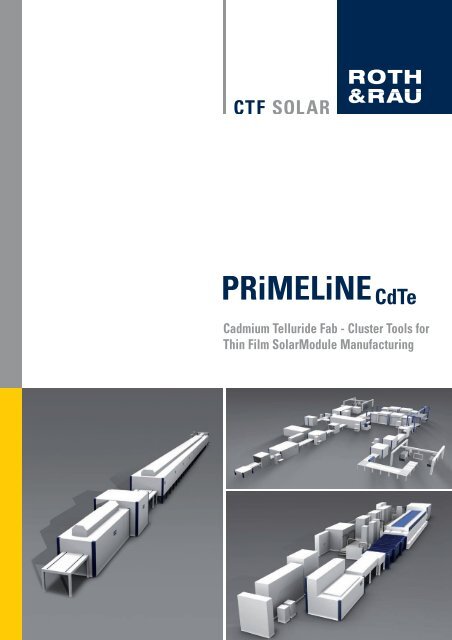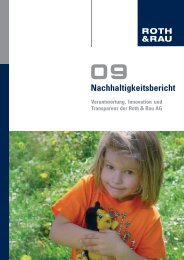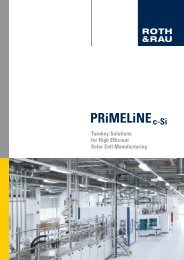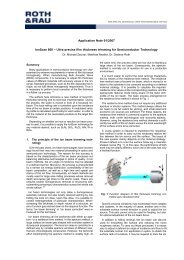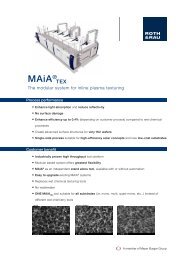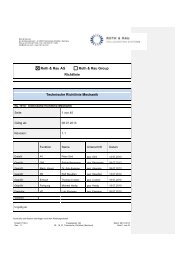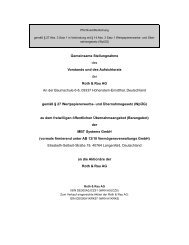PRiMELiNE - Roth & Rau AG
PRiMELiNE - Roth & Rau AG
PRiMELiNE - Roth & Rau AG
Create successful ePaper yourself
Turn your PDF publications into a flip-book with our unique Google optimized e-Paper software.
<strong>PRiMELiNE</strong> CdTe<br />
Cadmium Telluride Fab - Cluster Tools for<br />
Thin Film SolarModule Manufacturing
<strong>PRiMELiNE</strong><br />
Turnkey Solutions by <strong>Roth</strong> & <strong>Rau</strong><br />
Under the brand name <strong>PRiMELiNE</strong> <strong>Roth</strong> & <strong>Rau</strong> offers PV turnkey<br />
lines assuring a successful implementation of a state of the art<br />
production facility. Now, <strong>Roth</strong> & <strong>Rau</strong> CTF Solar is the first company<br />
worldwide to offer turnkey solutions for the production of Thin<br />
Film PV Modules, based on the reliable CdTe-technology.<br />
The advantages of the <strong>Roth</strong> & <strong>Rau</strong> turnkey offering are obvious:<br />
The “One-stop-shopping” solution has been designed for customers<br />
wanting to focus on their core business and wanting to<br />
rely on a strong partner with a proven track record of successfully<br />
realized turnkey projects worldwide.<br />
With a <strong>PRiMELiNE</strong> CdTe Turnkey Line <strong>Roth</strong> & <strong>Rau</strong> delivers state-ofthe-art<br />
and future proof technology, based on a continuous improvement<br />
of all components of the turnkey line, their integration,<br />
and accurate process design. To keep track with the continuous<br />
development in high technology, <strong>Roth</strong> & <strong>Rau</strong> maintains a broad<br />
network with renowned Research & Development partners.<br />
<strong>Roth</strong> & <strong>Rau</strong> is proud of its international appreciation as technologically<br />
leading company based on its strong commitment to<br />
R&D. Our continuous equipment improvement ensures a long lifetime<br />
of our <strong>PRiMELiNE</strong> CdTe product. The focal points in all development<br />
activities of the <strong>PRiMELiNE</strong> CdTe turnkey line are: Environmental<br />
responsibility, superior Cost of Ownership (CoO) and technological<br />
leadership. One of the outcomes of these principles is<br />
the design of the <strong>PRiMELiNE</strong> CdTe following the “Emission-free fab”<br />
concept, allowing operation of the production line with emissions<br />
close to zero.<br />
For customers that already invested into a CdTe Thin Film factory or<br />
who wish to integrate own or local content, <strong>Roth</strong> & <strong>Rau</strong> CTF Solar<br />
offers cost efficient, proven processing tool clusters that can be<br />
seamlessly integrated into either new production lines as well as<br />
into existing lines. The sum of all fully integrated clusters is the<br />
innovative yet proven <strong>PRiMELiNE</strong> CdTe Turnkey production line. The<br />
turnkey clusters are designed to provide specific process knowledge<br />
combined with suitable process equipment and processing<br />
material specification, project management and equipment startup<br />
for highest process reliability and product quality. All<br />
<strong>PRiMELiNE</strong> CdTe Clusters are capable of processing module sizes<br />
of up to 1200 x 1600 mm, with a throughput of up to 70 modules<br />
per hour. The table below provides to you an overview on our<br />
<strong>PRiMELiNE</strong> CdTe 80 MW Turnkey line offering and our PRiME-<br />
LiNE CdTe Turnkey clusters.
<strong>PRiMELiNE</strong> CdTe Laser Cluster (80 MW)<br />
CdTe Thin Film PV Modules have been recognized as the markets<br />
most cost efficient solution for PV applications. To support cost<br />
efficient, proven processing, <strong>Roth</strong> & <strong>Rau</strong> CTF Solar offers processing<br />
clusters and tools for all thin film PV module customers<br />
worldwide that can be seamlessly integrated into new production<br />
lines as well as into existing fabrication lines. The <strong>Roth</strong> & <strong>Rau</strong> CTF<br />
Solar chosen cluster design provides to the customer specific<br />
process knowledge combined with suitable process equipment<br />
and processing materials, project management and equipment<br />
startup in order to enhance product quality and module efficiencies.<br />
All <strong>PRiMELiNE</strong> CdTe Clusters are capable of processing standard<br />
module sizes of 1200 x 1600 mm (other dimensions on<br />
request), with a throughput of > 60 modules per hour. Basis for the<br />
design of all <strong>PRiMELiNE</strong> CdTe Cluster Tools is the innovative yet<br />
proven <strong>PRiMELiNE</strong> CdTe Turnkey production line.<br />
The <strong>PRiMELiNE</strong> CdTe Laser Cluster contains three Laser Scribers<br />
for P1, P2, P3 cuts and a Laser Edge Deletion tool. Equipment<br />
selection is optimized for use on CdTe. Although the individual<br />
tools of the Laser Tool cluster are spread inside the sequential<br />
tool layout of a thin film production line, customers can benefit<br />
from this tool package as all tools are matched with respect to<br />
performance and specification for optimized utilization of active<br />
module surface area.<br />
Thin film PV modules require several special processing steps in<br />
order to generate a pattern of multiple PV sub cells that needs to<br />
be very precise, as well as a fast and reliable layer removal without<br />
damaging the substrate itself for preparation of the backend<br />
edge sealing process. Therefore the application of laserbased<br />
tools is just a logical consequence, as laser tools are known as<br />
precise and powerful machining tools.<br />
Laser Scribers for P1, P2, P3 cuts<br />
These laser systems are used for scribing of the thin-films of conductive<br />
and semi-conductive materials on large substrates to produce<br />
stripes of defined width parallel to the substrate´s long or<br />
short edge depending on the modules' cell orientation. The position<br />
of each P1, P2, and P3 scribe is shifted by a small distance in<br />
order to connect all sub cells serially to each other. To guarantee<br />
for minimal distances between P1 and P2 resp. P3 cuts both P2<br />
and P3 laser use a dynamic line tracking mechanism; this feature<br />
provides for optimized active cell areas and - in total - for high<br />
module efficiencies. The number and width of the individual sub<br />
cells are optimized for a maximum utilization of active module surface.<br />
The Scribing tools are programmable; to achieve sufficient<br />
throughput each Scribing tool is equipped with several pulsed<br />
lasers, and each laser beam is split into several cutting beams.<br />
In accordance with the layer composition each tool's laser<br />
wavelength is adapted; used laser wavelengths are 532 nm resp.<br />
1064 nm. Damage of underlying layers is avoided, which is of special<br />
importance for P2 and P3 cuts: Both cuts are not allowed to<br />
cut into the underlying TCO layer. All laser tools use a dynamic,<br />
active focusing for excellent scribing process<br />
Key features:<br />
Throughput > 60 substrates/h<br />
Module size up to 1200 x 1600 mm<br />
Scribing line width 35 - 70 m,<br />
Line-to-line distance 5 - 15 mm<br />
(adjustable per software setting)<br />
Multiple processing beams, depending<br />
on specific requirements<br />
Air bearings to guide laser axis‘<br />
Massive granite processing table<br />
for optimum accuracy<br />
Dynamic focusing (optional)<br />
Dynamic line tracking (optional)<br />
Integrated laser fumes exhaust<br />
and filtration system<br />
Integrated P1 and P2 input substrate cooling
<strong>PRiMELiNE</strong><br />
Turnkey Solutions by <strong>Roth</strong> & <strong>Rau</strong><br />
Laser Edge Deletion tool<br />
The Edge Ablation Machine removes all deposited layers around<br />
the substrate with a programmable width on the substrate front<br />
side and - additionally - around its outer edges. Precision, high<br />
process speed and stability, and a residue-free processing are<br />
key for this machine.<br />
Key features:<br />
Nd-Y<strong>AG</strong> high-energy laser with scanner<br />
Laser wavelength 1030 - 1060 nm<br />
Programmable ablation widths in steps<br />
between 2 - 30 mm width<br />
Optional dynamic focusing<br />
Process integrated quality inspection<br />
Integrated laser fumes exhaust system<br />
All Laser tools are designed to comply with the <strong>Roth</strong> & <strong>Rau</strong> CTF<br />
Solar principle of delivering only environmental friendly tools, as<br />
also realized in the entire <strong>PRiMELiNE</strong> CdTe turnkey production line,<br />
which is designed to keep the "environmental footprint" as small<br />
as possible:<br />
All fab emissions are post-treated already at tool-level so that virtually<br />
no contaminated or hazardous substances can be released<br />
to the environment, and used processing fluids are recycled for<br />
minimal consumption values<br />
Turnkey Cluster<br />
<strong>PRiMELiNE</strong> CdTe Laser Cluster (80 MW)<br />
Project duration<br />
Cluster content<br />
12 months<br />
– Optimization of Scribing Pattern<br />
– Laser Scribing 1<br />
– Laser Scribing 2<br />
– Laser Scribing 3<br />
– Scribing Quality Monitoring Each<br />
– Substrate Temperature Control for Scribing 1 to 3<br />
– Automated focus control<br />
– Dynamic Scribing Distance Control for Scribing 2 and 3<br />
– Laser Edge Deletion<br />
– Exhaust Air Filtration Safety Housings<br />
– Other relevant EHS Provisions
<strong>PRiMELiNE</strong> CdTe Coating Cluster (80 MW)<br />
CdTe Thin Film PV Modules have been recognized as the markets<br />
most cost efficient solution for PV applications. To support cost<br />
efficient, proven processing, <strong>Roth</strong> & <strong>Rau</strong> CTF Solar offers processing<br />
clusters and tools for all CdTe customers worldwide that<br />
can be seamlessly integrated into new production lines as well<br />
as into existing fabrication lines. The <strong>Roth</strong> & <strong>Rau</strong> CTF Solar chosen<br />
cluster design provides to the customer specific process<br />
knowledge combined with suitable process equipment and processing<br />
materials, project management and equipment startup<br />
in order to enhance product quality and module efficiencies.<br />
All <strong>PRiMELiNE</strong> CdTe Clusters are capable of processing standard<br />
module sizes of 1200 x 1600 mm (other dimensions on request),<br />
with a throughput of > 60 modules per hour. Basis for the design<br />
of all <strong>PRiMELiNE</strong> CdTe Cluster Tools is the innovative yet proven<br />
<strong>PRiMELiNE</strong> CdTe Turnkey production line.<br />
The key process in manufacturing of CdTe PV modules is the deposition<br />
of the photo-active CdS (Cadmium Sulfide) and CdTe<br />
(Cadmium Telluride) layers onto the substrate. Module efficiency<br />
is mainly predetermined in these critical process steps. The<br />
<strong>Roth</strong> & <strong>Rau</strong> CTF Solar CSS (Closed Space Sublimation) Deposition<br />
Tool is a vacuum-based tool that incorporates many years of field<br />
proven deposition technology: Based on commercial scale coating<br />
equipment using this deposition technology CdTe cells of<br />
12,7% efficiency have been achieved.<br />
In the current generation of the CSS Tool many enhancements<br />
and design optimizations have been implemented, therefore deposition<br />
rates, film thickness uniformities, film qualities and tool<br />
reliability are among the highest within the market. The deposition<br />
process originally developed at the Batelle institute and producing<br />
the world-record CdTe cell efficiency, is performed in a vacuum<br />
atmosphere and at high temperatures (> 500 °C). The substrates<br />
are fed into the CSS Deposition Tool as a substrate band,<br />
transport speed is continuous at about 1.5 m/min. The layers are<br />
deposited at the bottom surface of the substrates by nucleation of<br />
CdS respectively CdTe vapours on the substrate surface. Due to<br />
its unique technology the current <strong>Roth</strong> & <strong>Rau</strong> CTF Solar deposition<br />
process is the far cleanest CdS / CdTe deposition technology<br />
available worldwide. Included in the CSS Deposition tool is an<br />
integrated cooling section that carefully cools the substrates to<br />
ambient temperature without introducing thermal stress and<br />
therefore contributing to long module lifetimes.<br />
Typical film thicknesses are 30 - 100 nm CdS, and 2 - 5 m CdTe.<br />
A major feature of the CSS deposition technology is - unlike films<br />
deposited with non-vacuum conditions - the formation of dense,<br />
non-porous films. Raw materials are utilized with > 95%, contributing<br />
to the low CoO of the CSS Deposition Tool. It operates<br />
fully automatic, it is programmable to achieve best process<br />
results on various types of substrates.<br />
The deposition zone is contained by a special exhausted and<br />
filtered enclosure; hazardous materials are handled exclusively<br />
within this enclosure, additionally the entire tool is contained<br />
in a second enclosure, providing for an EHS-proof design. This<br />
feature adds to the <strong>Roth</strong> & <strong>Rau</strong> CTF Solar principle of delivering<br />
only environmental friendly tools, as also realized in the entire<br />
<strong>PRiMELiNE</strong> CdTe turnkey production line, which is designed to keep<br />
the "environmental footprint" as small as possible: All fab emissions<br />
are post-treated already at tool-level so that virtually no<br />
contaminated or hazardous substances can be released to the<br />
environment, and used processing fluids are recycled for minimal<br />
consumption values.<br />
Key features:<br />
Short substrate edge leading<br />
Cycle time < 60 s<br />
Deposition temperature app. 600°C<br />
Integrated exhaust filtration<br />
Integrated heating and cooling zones<br />
Vacuum pumps<br />
Deposition zone for sequential deposition<br />
of both CdS and CdTe<br />
Low fab facility requirements<br />
Double enclosure design providing for<br />
high ESH standards.
<strong>PRiMELiNE</strong> CdTe Activation Cluster (80 MW)<br />
CdTe Thin Film PV Modules have been recognized as the markets<br />
most cost efficient solution for PV applications. Various CdTe deposition<br />
processes have been established, whereas the basic processing<br />
around the CdS / CdTe layering is rather similar in all<br />
CdTe production lines. To support cost efficient, proven processing<br />
<strong>Roth</strong> & <strong>Rau</strong> CTF Solar offers processing clusters for all CdTe<br />
customers worldwide that can be seamlessly integrated into<br />
new production lines as well as into existing fabrication lines. The<br />
<strong>Roth</strong> & <strong>Rau</strong> CTF Solar chosen cluster design provides to the customer<br />
specific process knowledge combined with suitable<br />
process equipment and processing materials, project management<br />
and equipment startup in order to enhance product quality<br />
and module efficiencies. All <strong>PRiMELiNE</strong> CdTe Clusters are capable<br />
of processing standard module sizes of 1200 x 1600 mm (other<br />
dimensions on request), with a throughput of > 60 modules per<br />
hour. Basis for the design of all <strong>PRiMELiNE</strong> CdTe Cluster Tools is the<br />
innovative yet proven <strong>PRiMELiNE</strong> CdTe Turnkey production line. The<br />
<strong>Roth</strong> & <strong>Rau</strong> CTF Solar principle of delivering only environmental<br />
friendly tools, as realized in the entire <strong>PRiMELiNE</strong> CdTe turnkey production<br />
line, which is designed to keep the "environmental footprint"<br />
as small as possible, applies also to the<br />
For a seamless integration into existing production lines the<br />
<strong>PRiMELiNE</strong> CdTe Activation Cluster uses a standardized SECS/GEM<br />
protocol, substrate-ID-tracking (virtual / DMC reader), and adaptable<br />
horizontal communication with adjacent process tools.<br />
Nevertheless, the cluster can be operated also fully autonomous,<br />
with recipe administration on Cluster level.<br />
In detail, the <strong>PRiMELiNE</strong> CdTe Activation Cluster consists of a Coating<br />
Machine, an Activation Furnace, and a Cascade Washing/Cascade<br />
Rinsing tool.<br />
<strong>Roth</strong> & <strong>Rau</strong> Activation Cluster<br />
All fab emissions are post-treated already at tool-level so that virtually<br />
no contaminated or hazardous substances can be released<br />
to the environment. Also, the entire Cluster is enclosed with a<br />
safety housing to contain all hazardous substances and to avoid<br />
any contamination of the remaining production environment. A very<br />
critical step in processing of CdTe PV-modules is the activation of<br />
the CdS / CdTe layer stack with its target to improve the physical as<br />
well as electro-optical properties of the CdS / CdTe stack. Here, as<br />
also applied by leading CdTe solar module producers, a dedicated<br />
CdCl 2 activation, combining a CdCl 2 deposition plus a subsequent<br />
heat treatment, is used. The <strong>Roth</strong> & <strong>Rau</strong> CTF Solar processing solution<br />
provides all necessary tools plus appropriate, perfectly harmonized<br />
materials and process selection for a cost efficient activation<br />
and enhanced module efficiency.<br />
Therefore the <strong>Roth</strong> & <strong>Rau</strong> CTF Solar Activation Cluster can be a reliable<br />
retrofit for tools in existing production lines while adding<br />
improved module performance for shorter payback times of investments.<br />
However, together with the <strong>Roth</strong> & <strong>Rau</strong> CSS type of CdS /<br />
CdTe films and its characteristic properties the Activation Cluster<br />
tool offers a perfectly harmonized chemical activation process.<br />
Coating Machine<br />
During fully automatic processing within the coating tool an<br />
aqueous film containing dissolved CdCl 2 is applied in a defined<br />
thickness on the surface of the glass pane utilizing a specially<br />
engineered roller-coating system. Adding a specially formulated<br />
mixture to the coating solution allows for an excellent<br />
uniformity of the liquid film over the entire surface by improving<br />
the specific wetting characteristics. The preparation of the<br />
coating solution is done in a dedicated chemical cabinet next to<br />
the core process modules of the tool taking care of the specific<br />
handling precautions of the used materials. After successfully<br />
depositing the solution onto the substrate a drying step safely<br />
removes all liquid remnants while the CdCl 2 remains on top of<br />
the CdTe layer. As part of the <strong>Roth</strong> & <strong>Rau</strong> CTF Solar Activation<br />
Cluster all necessary peripherals to prevent the release of hazardous<br />
liquids and gases are included. A closed loop DI water<br />
supply is available as an option to account for low operating<br />
costs and low factory facility requirements.
<strong>PRiMELiNE</strong><br />
Turnkey Solutions by <strong>Roth</strong> & <strong>Rau</strong><br />
Key features:<br />
Short substrate edge leading<br />
Layer stack facing upwards<br />
Cycle time < 60 s<br />
Integrated substrate heating<br />
Selectable composition of CdCl 2 -solution<br />
Closed-loop waste water reconditioning<br />
Integrated exhaust filtration<br />
Safety housing<br />
Automatic cleaning routines for<br />
easy maintenance..<br />
Cascade Washing/ Cascade Rinsing tool<br />
After deposition and tempering of the CdCl 2 layer all remaining<br />
residues are removed in a cleaning step so that the substrates<br />
can be processed in subsequent process steps without any<br />
risk of CdCl 2 contamination to tools and operators. The cascade<br />
washing machine is the final tool within performing the activation<br />
process.<br />
DI-water is applied stepwise on all substrate surfaces utilizing<br />
the eponymous "cascade"-setup of cleaning modules. The procedure<br />
is performed without adding any chemical additives to the<br />
rinse water. After removal of the CdCl 2 layer the substrates are<br />
automatically transferred to an integrated drying section where<br />
liquid film is evaporated. All used DI-water is collected and recycled<br />
on tool level.<br />
Activation Furnace<br />
In close combination with the coating tool the activation furnace<br />
supports the restructuring of the CdS / CdTe layer stack.<br />
After CdCl 2 coating the substrate enters the furnace where<br />
the glass pane is heated up to a defined and well controlled<br />
activation temperature.<br />
Temperature and transport speed are adjustable. Subsequent<br />
to the tempering process the substrate is cooled down carefully<br />
in order to avoid that thermal stress remains inside the<br />
glass. All mentioned steps are performed under standard<br />
atmospheric conditions.<br />
Key features:<br />
Long substrate edge leading<br />
Layer stack facing upwards<br />
Cycle time < 60 s<br />
Atmospheric process<br />
Activation temperature @ app. 400 °C<br />
Activation time adjustable between 10 - 20 min<br />
Integrated cooling tunnel<br />
Integrated filtration of exhaust gases - no special<br />
contaminated exhaust duct system necessary<br />
Safety housing
<strong>PRiMELiNE</strong><br />
Turnkey Solutions by <strong>Roth</strong> & <strong>Rau</strong><br />
Key features:<br />
Short substrate edge leading<br />
Chemical layer facing upwards<br />
Cycle times < 60 s<br />
Integrated recycling of used rinsing DI water<br />
No chemical additives needed<br />
Integrated dryer<br />
Safety housing<br />
Turnkey Cluster<br />
<strong>PRiMELiNE</strong> CdTe Coating Cluster plus<br />
<strong>PRiMELiNE</strong> CdTe Activation Cluster (80 MW)<br />
Project duration<br />
14 months<br />
Cluster content<br />
Coating Cluster<br />
– CdS/CdTe Coating (CSS)<br />
– Substrate Cooling Section<br />
– Vacuum System<br />
– Closed Loop Water cooling System<br />
– Safety Housings<br />
Activation Cluster<br />
– Conveyor<br />
– Conveyor EX, Conveyor EX SEL, Conveyor EX SEL Inspection,<br />
Conveyor EX LEL, Conveyor LEL, Conveyor SEL,<br />
Conveyor SEL Inspection<br />
– Activation Coating Unit<br />
– Rotary Table EX<br />
– Corner Transfer EX<br />
– Activation Furnace<br />
– Corner Transfer<br />
– Rotary Table<br />
– Cascade Rinsing + Closed Loop DI Water Regeneration<br />
– Safety Housings<br />
– Relevant EHS provisions<br />
– EHS Equipment
<strong>PRiMELiNE</strong> CdTe Back-Contact Cluster (80 MW)<br />
CdTe Thin Film PV Modules have been recognized as the markets<br />
most cost efficient solution for PV applications. To support cost<br />
efficient, proven processing <strong>Roth</strong> & <strong>Rau</strong> CTF Solar offers processing<br />
clusters and tools for all CdTe customers worldwide that<br />
can be seamlessly integrated into new production lines as well as<br />
into existing fabrication lines. The <strong>Roth</strong> & <strong>Rau</strong> CTF Solar chosen<br />
cluster design provides to the customer specific process knowledge<br />
combined with suitable process equipment and processing<br />
materials, project management and equipment startup in<br />
order to enhance product quality and module efficiencies. All<br />
<strong>PRiMELiNE</strong> CdTe Clusters are capable of processing standard module<br />
sizes of 1200 x 1600 mm (other dimensions on request), with<br />
a throughput of up to 70 modules per hour. Basis for the design<br />
of all <strong>PRiMELiNE</strong> CdTe Cluster Tools is the innovative yet proven<br />
<strong>PRiMELiNE</strong> CdTe Turnkey production line.<br />
A major process in manufacturing of CdTe PV modules is the formation<br />
of the back contact which allows for efficient collection of<br />
generated PV current. The <strong>Roth</strong> & <strong>Rau</strong> CTF Solar Back Contact<br />
cluster can be retrofitted for tools in existing production lines<br />
while adding improved module performance for shorter payback<br />
times of investments.<br />
In order to achieve high CdTe PV Module energy efficiencies,<br />
a low resistance back contact needs to be integrated into the<br />
CdTe Solar Module. This process step requires state-of-the-art<br />
know-how of CdTe surface preparation, back contact material<br />
selection, deposition technology, and equipment design to<br />
integrate the metallic back contact in the design of the CdTe PV<br />
module. In consequence, all sub-processes within this cluster<br />
are carefully adapted to each other and individually optimized<br />
with regard to etching rate, layer sequence, layer thickness,<br />
process homogeneity.<br />
The <strong>Roth</strong> & <strong>Rau</strong> CTF Solar Back-Contact processing provides for<br />
one of the lowest available film resistivity that enables high solar<br />
module energy efficiencies, high fill factor, long term stability, and<br />
compatibility with subsequent backend processes such as bus<br />
bar application and lamination.<br />
For a seamless integration into existing production lines the<br />
<strong>PRiMELiNE</strong> CdTe Back Contact Cluster uses a standardized SECS/<br />
GEM protocol, substrate-ID-tracking (virtual / DMC reader), and<br />
adaptable horizontal communication with adjacent process tools.<br />
Nevertheless, the cluster can be operated also fully autonomous,<br />
with recipe administration on Cluster level. All sub-processes are<br />
decoupled by a substrat buffer stations which allow for scheduled<br />
maintenance of single tools without interruption of production of<br />
other cluster tools. This provides for a high cluster uptime and a<br />
flexible maintenance planning.<br />
In detail, the <strong>PRiMELiNE</strong> CdTe Back Contact Cluster consists of a<br />
CdTe Surface Preparation tool and a Metal Contact Deposition tool.<br />
CdTe Surface Preparation Tool<br />
The surface preparation consists of an etching step to prepare<br />
the CdS / CdTe layer stack before it is fed into the metal deposition<br />
equipment. The target of the preparation process is to establish<br />
a p+-doped layer of defined thickness on top of the CdTe<br />
surface by removing the existing Cd while simultaneously enrichening<br />
Te by a special etching process. Any liquid residues are<br />
removed by subsequent rinsing of the substrate with DI water.<br />
Set up of the etching solution is done in a chemical cabinet located<br />
next to the core process modules of the machine. Drained<br />
etching solution is collected and treated in a waste water subsystem.<br />
Traces of hazardous gases that may be generated during<br />
processing of the substrate are safely exhausted to a customized<br />
filtration unit.<br />
Key features:<br />
Short substrate edge leading<br />
Chemical layer facing upwards<br />
Cycle time < 60 s<br />
Selectable composition of etchingsolution<br />
Actively controlled etching rate and composition<br />
of etching solution with automatic compensation<br />
for selective consumption of components<br />
Integrated substrate rinsing and drying, integrated<br />
exhaust filtration<br />
Optionally available with a closed loop for flushing<br />
DI-water - no external DI-water supply required<br />
No release of contaminated waste water
<strong>PRiMELiNE</strong><br />
Turnkey Solutions by <strong>Roth</strong> & <strong>Rau</strong><br />
Metal Contact Deposition tool<br />
After chemical preparation the substrates are automatically<br />
transferred into the metal contact deposition tool. The back contact<br />
processing is accomplished with a dedicated PVD process,<br />
within this process several metal materials can be sputtered onto<br />
the CdS / CdTe layer stack in order to optimize sheet resistance of<br />
the sputtered layers. Sputtered layer composition and processing<br />
conditions may be optimized depending on customer requirements.<br />
The metal contact deposition tool is explicitly designed for exceptional<br />
high production performance with long uninterrupted<br />
sputtering times and a synchronized sputter target lifetime<br />
with optimized preventive maintenance intervals to achieve high<br />
tool uptime.<br />
Key features:<br />
Short substrate edge leading,<br />
layer stack facing upwards<br />
Cycle time < 60 sec.<br />
Long uninterrupted sputter campaigns<br />
High process stability and accuracy<br />
High yield, high reliability, high availability<br />
Maintenance friendly<br />
Vacuum pumps included<br />
Integrated substrate heating for hot sputtering<br />
Integrated filtration of exhaust gases<br />
Integrated cooling zone<br />
All Back Contact Deposition tools are designed to comply with the<br />
<strong>Roth</strong> & <strong>Rau</strong> CTF Solar principle of delivering only environmental<br />
friendly tools, as also realized in the entire <strong>PRiMELiNE</strong> CdTe turnkey<br />
production line, which is designed to keep the "environmental<br />
footprint" as small as possible: All fab emissions are post-treated<br />
already at tool-level so that virtually no contaminated or hazardous<br />
substances can be released to the environment, and used<br />
processing fluids are recycled for minimal consumption values.<br />
Turnkey Cluster<br />
<strong>PRiMELiNE</strong> CdTe Back-Contact Cluster (80 MW)<br />
Project duration<br />
Cluster content<br />
13 months<br />
– Etching station with closed loop DI-water<br />
supply and wastewater treatment<br />
– 2 conveyors<br />
– Buffer station incl. 3 storage boxes<br />
– Back-contact magnetron sputtering machine<br />
– Substrate cooling section<br />
– EHS equipment
<strong>PRiMELiNE</strong> CdTe Back-End Cluster (80 MW)<br />
CdTe Thin Film PV Modules have been recognized as the markets<br />
most cost efficient solution for PV applications. To support cost<br />
efficient and proven processing <strong>Roth</strong> & <strong>Rau</strong> CTF Solar offers processing<br />
clusters and tools for all thinfilm PV customers worldwide<br />
that can be seamlessly integrated into new production lines as<br />
well as into existing fabrication lines. The <strong>Roth</strong> & <strong>Rau</strong> CTF Solar<br />
chosen cluster design provides to the customer specific process<br />
knowledge combined with suitable process equipment and<br />
processing materials, project management and equipment startup<br />
in order to enhance product quality and module efficiencies.<br />
All <strong>PRiMELiNE</strong> CdTe Clusters are capable of processing standard<br />
module sizes of 1200 x 1600 mm (other dimensions on request),<br />
with a throughput of > 60 modules per hour. Basis for the design<br />
of all <strong>PRiMELiNE</strong> CdTe Cluster Tools is the innovative yet proven<br />
<strong>PRiMELiNE</strong> CdTe Turnkey production line.<br />
The backend processing of PV modules is crucial for achieving<br />
high module reliability and lifetime. Especially module certification<br />
acc. to DIN EN 61464 and DIN-EN 61740-1/2 is highly<br />
dependent on the overall quality of the Back-End process. The<br />
<strong>Roth</strong> & <strong>Rau</strong> CTF Solar Back-End Cluster provides for a well engineered<br />
total solution, including material selection, process know<br />
how, and equipment specification and therefore ensures for a<br />
"glitch-free" product certification and PV module lifetimes > 20<br />
years. The <strong>PRiMELiNE</strong> CdTe Backend Cluster is specifically designed<br />
for CdTe photovoltaic modules. To provide for a balanced<br />
investment cost optimization a mix of automatic and manual processes<br />
is chosen.<br />
The <strong>Roth</strong> & <strong>Rau</strong> CTF Solar Back-End Cluster comprises a complex<br />
sequence of module processing tools: Module test, busbar application,<br />
edge sealing, marriage (e.g. application of encapsulant foil<br />
plus layering of backside glass), lamination, junction box application,<br />
and final testing (flasher, wet leakage, and metrology) plus<br />
labeling. An optimized, integrated substrate buffering concept<br />
(buffer station with exchangeable storage boxes, FILO buffers,<br />
loading stations) is integrated into the cluster design which<br />
allows for flexible maintenance schedules and reduced impact of<br />
unscheduled equipment events. Of course all intermediate substrate<br />
transport devices necessary for operation of the entire<br />
Back-End are included in the Cluster design.<br />
For a seamless integration into existing production lines the<br />
<strong>Roth</strong> & <strong>Rau</strong> CTF Solar Back-End Cluster uses a standardized<br />
SECS/GEM protocol, substrate-ID-tracking (virtual / DMC reader),<br />
and adaptable horizontal communication with adjacent process<br />
tools.<br />
The Module Tester yields a Go/No Go decision and determines if<br />
the module is worth applying the backend process. This is accomplished<br />
by an automatic I-V-curve tracing when applying light to<br />
the module and allows for a calculation of most electrical key<br />
parameters ( Isc, V0C, Pmax, FF, Rserieal, Rparallel). The Module<br />
Tester uses state-of-the-art LED lighting which allows for long<br />
uptimes and reliable functionality.<br />
In the Busbar Application machine the module's sub cells are<br />
connected via a conductive, low-loss Cu-ribbon and a conductive<br />
silver paste. Alternatively soldering or ultrasonic welding<br />
methods can be used, depending on the specific physical properties<br />
of the photovoltaic layers. All components in this process are<br />
carefully selected with special attention to long-term reliability<br />
of the module.<br />
The Edges Sealing tool applies an UV-stable and highly resistive<br />
string of sealant, variable in width and thickness, in an extrusion<br />
process. Other than in available Back-End processes this special<br />
process serves as an additional barrier against humidity penetrating<br />
into the module and is therefore part of the "dual component"<br />
sealing solution. <strong>Roth</strong> & <strong>Rau</strong> CTF Solar delivers to its customers<br />
an optimized and tested combination from equipment, material,<br />
and application process for an unsurpassed module lifetime.
<strong>PRiMELiNE</strong><br />
Turnkey Solutions by <strong>Roth</strong> & <strong>Rau</strong><br />
After mounting of busbars and application of edge sealant<br />
the processed substrate, the washed and cleaned back glass,<br />
and the encapsulant foil are mounted together to a stacked sandwich.<br />
This fully automated process tool is called "marriage".<br />
The marriage station is designed to process glass and encapsulant<br />
foil for module sizes up to 1200 x 1600 mm; encapsulant foil<br />
material may be EVA or PVB, which is fed to the machine from<br />
rolls and then cut to the appropriate size and precisely placed<br />
onto the substrate. Encapsulant foil size and positioning with<br />
respect to the edge sealant "frame" is essential for a good subsequent<br />
lamination process result.<br />
The Laminator forms a mechanical stable module from the glassfoil-glass<br />
stack created in the process before, that can withstand<br />
all environmental effects that a PV module is exposed to. This is<br />
accomplished by applying heat and pressure to the stack for a<br />
defined time. Temperatures are adjustable and precisely controllable,<br />
depending on the encapsulant foil material. Pressure is<br />
adjusted in order to obtain a bubble-free, homogenously polymerized<br />
encapsulant material. Included in the scope of delivery is the<br />
integrated cooling press to cool down the modules to temperatures<br />
that allow safe subsequent processing.<br />
After lamination the PV module is almost ready, only the specially<br />
adapted junction box needs to be connected to the busbar on the<br />
module backside. This process step can be executed either manually<br />
or fully automatic, with crimp or soldering connection to the<br />
busbar, with adhesive pads, hot melts or silicone adhesives, with<br />
metal or polymer junction boxes: Obviously, all customer requirements<br />
can be fully met by the flexible process station design.<br />
Final testing consists of a Flasher, a Wet Leakage Tester, and a<br />
Visual Inspection Station. Flashing simulates PV module output at<br />
sunlike illumination (STC, 1000 W/m 2 , AM 1.5 global) and therefore<br />
enables determination of module output parameters Pmax, Impp,<br />
Umpp, Isc, Uoc, and - finally - the module efficiency . Design of the<br />
Flasher may be either horizontally or vertically, depending on the<br />
individual requirements at customer's site.<br />
A Wet Leakage Test (= High Potential Test) ensures proper electrical<br />
insulation of the module. UL1703 and IEC61730 are the basic<br />
standards, covering requirements for safety and construction of<br />
photovoltaic modules to address prevention of electrical shock<br />
and fire hazards. These two base standards are to be used in conjunction<br />
with IEC61646. Only modules that pass this test are<br />
considered as "sellable modules" and will be labeled according<br />
to its output power. Label printer and software connection to<br />
Flasher and Wet Leakage tester is included in the Backend Cluster<br />
design. Metrology tools utilized within the <strong>Roth</strong> & <strong>Rau</strong> CTF Solar<br />
Back-End Cluster comprise of a back glass inspection (broken<br />
corners, chipping, and edge cracks) and a module inspection<br />
(lamination bubbles, lamination inclusions, glass breakage). All<br />
inspections are fully automatic, incorporating image recognition<br />
and analysis. Optionally, additional inspection methods (electro<br />
luminescence, photo luminescence) can be integrated in the<br />
Back-End Cluster layout.<br />
Key features:<br />
Cluster output > 60 substrates / h<br />
Integrated substrate transport system<br />
Short substrate edge leading<br />
Integrated inspection and metrology (adaptable)<br />
Flexible process design (adaptable to various<br />
encapsulant foil materials<br />
Junction box designs, process/throughput<br />
requirements at lamination<br />
Flasher mechanical design),<br />
Xenon lamp flashing<br />
Automatic module labeling<br />
Flexible and adaptable MES connection<br />
Integrated cooling press at the laminator<br />
All Back-End tools are designed to comply with the <strong>Roth</strong> & <strong>Rau</strong><br />
CTF Solar principle of delivering only environmental friendly tools,<br />
as also realized in the entire <strong>PRiMELiNE</strong> CdTe Turnkey production<br />
line, which is designed to keep the "environmental footprint" as<br />
small as possible: All fab emissions are post-treated already at<br />
tool-level so that virtually no contaminated or hazardous substances<br />
can be released to the environment, and used processing<br />
fluids are recycled for minimal consumption values.
Turnkey Cluster<br />
<strong>PRiMELiNE</strong> CdTe Back-End Cluster (80 MW)<br />
Project duration<br />
Cluster content<br />
13 months<br />
– 2 Buffer Stations<br />
– Bus bar application<br />
– All necessary substrate transport<br />
(14 conveyor SEL, 6 conveyor EX SEL, rotary table)<br />
– Edge sealing (butyl)<br />
– 2 FILO buffer 30 subs<br />
– Back glass washer plus closed loop wastewater treatment<br />
– Back glass loading station<br />
– Back glass inspections<br />
– Corner transfer<br />
– Buffer station incl. 3 storage boxes<br />
– Marriage station + foil loader + slicing<br />
– Lamination loading<br />
(10 corner transfers, 7 conveyor LEL, 2 rotary tables)<br />
– Laminators (including cooling press)<br />
– Lamination unloading (portal crane)<br />
– FILO buffer 50 subs<br />
– Automated lamination quality inspection<br />
– Manual junction box mounting station<br />
– High potential test<br />
– Flash tester<br />
– Labeling<br />
– Unloading station for finished modules<br />
– EHS equipment
<strong>PRiMELiNE</strong><br />
Turnkey Solutions by <strong>Roth</strong> & <strong>Rau</strong><br />
Turnkey Cluster<br />
<strong>PRiMELiNE</strong> CdTe Automation and Metrology Cluster (80 MW) and MES<br />
Project duration<br />
Cluster content<br />
14 months<br />
– Substrate Marking<br />
– Substrate Tracking System<br />
– Substrate Transport System<br />
– Substrate-Inspection<br />
– x Buffer Substrate Stations<br />
– Buffer- & Transport Boxes for 1.400 plus substrates<br />
– Cooling sections<br />
– Heating sections<br />
– PV Function Check<br />
– MES and Line integration services<br />
Turnkey Cluster<br />
<strong>PRiMELiNE</strong> CdTe Ramp-Up Cluster<br />
Project duration<br />
9 months<br />
Cluster content<br />
– Shipping<br />
– Data pack for building permit<br />
– EHS data pack<br />
– Move-in/ Move-in Project Management<br />
– Turnkey Project Management<br />
– Full service Ramp-up<br />
– Staff training<br />
– EHS Consulting<br />
– Material Management Consulting<br />
– Raw Materials and Component Specification<br />
– Staff training (“classroom” and “on the job”)<br />
– Total Annual Output and Efficiency Warranty<br />
Turnkey Cluster<br />
Total <strong>PRiMELiNE</strong> CdTe Cluster + Service /<br />
Complete Turnkey Line 80 MW<br />
Project duration<br />
24 months
<strong>PRiMELiNE</strong> CdTe - Turnkey solutions by <strong>Roth</strong> & <strong>Rau</strong><br />
Turnkey solution features<br />
All equipment from one hand<br />
Developing new generations of turnkey solutions<br />
The best developed sales and service network<br />
in photovoltaics worldwide<br />
<strong>Roth</strong> & <strong>Rau</strong> CTF Solar is the first supplier of<br />
complete production lines and cluster tools<br />
for cadmium-telluride thin film solar modules<br />
Our Scope<br />
Customer‘s Benefits<br />
Integrated equipment, technology and service package<br />
Factory layout assistance<br />
Equipment installation and start-up procedure<br />
Technology transfer and production<br />
Ramp-up support<br />
Training of the staff<br />
After sales service and support in spare part logistics<br />
Quick mass production launch<br />
High technology level<br />
Low running cost<br />
High marketing acceptance for the product<br />
(20% market share in world PV market)<br />
Esthetical appearance<br />
Very good performances at diffuse sunlight<br />
and high temperatures<br />
High marketing acceptance for the product (20% market share in world PV market)<br />
Esthetical appearance<br />
Very good performances at diffuse sunlight and high temperatures
<strong>Roth</strong> & <strong>Rau</strong> CTF Solar GmbH<br />
An der Baumschule 6-8<br />
09337 Hohenstein-Ernstthal<br />
Germany<br />
Phone +49 3723 66 85 0<br />
Fax +49 3723 66 85 100<br />
E-mail info@roth-rau.com<br />
www.roth-rau.com


